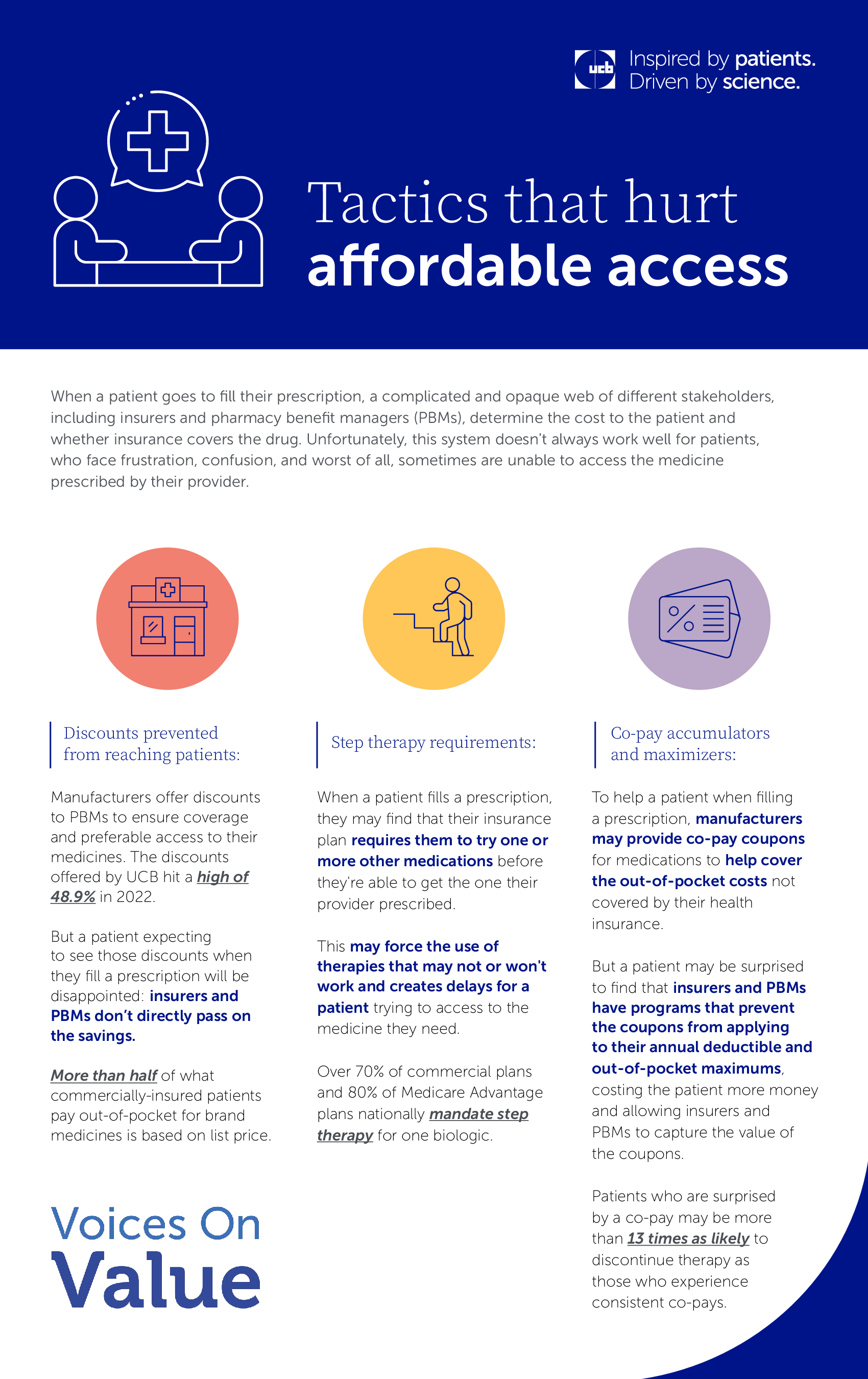
When a patient fills a prescription, the act of paying for their medicine has the illusion of being a straightforward transaction, like buying toothpaste or apples. The consumer exchanges money, and they receive the product in return.
But, in the real world, comparing medicines to produce is hardly an apples-to-apples comparison. There is a complicated and opaque web of different stakeholders who play a part in determining what the patient pays – and whether their insurance will even cover the medicine prescribed by their healthcare provider.
When the system works well, this process works seamlessly. But when it breaks down, patients are faced with frustration, confusion – and potentially, without access to a needed medication.
At UCB, we work every day to discover and deliver differentiated solutions to give people impacted by severe diseases more options that help them live the best life they can, whatever that means for them. We believe the healthcare system needs to evolve further to serve patients better, including taking a closer look at how medicines make their way from researchers and manufacturers, through a twisting set of intermediaries, to patients.
Spotlight: Insurers and PBMs
We call that twisting set of intermediaries the “value chain.” Among the biggest elements of that value chain – that may or may not provide value to patients – are insurers and pharmacy benefit managers (PBMs).
PBMs serve as middlemen between manufacturers and insurers along with employers, managing benefits and negotiating discounts on the insurer’s behalf. There is no innovation in this step of the process. Unlike manufacturers, they are not discovering and developing medicines.
Typically, for a medicine developed by UCB to reach a patient, UCB must negotiate discounts and rebates with a PBM to obtain a spot on an insurer’s formulary. Those discounts and rebates are large and growing: UCB’s discounts hit an all-time high of 48.9% in 2022, meaning UCB provided substantial discounts and rebates as part of negotiations with health insurers and statutorily required government discounts.
While these rebates and discounts should directly translate to lower costs for patients filling a prescription, in the current U.S. healthcare system, unfortunately, patients too often do not benefit from those discounts.
UCB is firmly committed to promoting affordable access to care for patients and removing undue barriers when the value chain breaks down.
Tactics that Hurt Affordable Access for Patients
In addition to not passing along rebates and discounts, there are two tactics PBMs use to mitigate their own costs while putting patient access and affordability at risk, particularly for people living with immunological or neurological diseases: step therapy and co-pay accumulator and maximizer programs.
Step Therapy
Step therapy policies require a patient to try one or more treatments that may not work or won’t work – usually less expensive options – before getting access to the prescribed treatment, as determined by the healthcare provider based on the individual needs and circumstances of the patient.
Step therapy requirements may offer short-term savings, but they often drive-up health system costs in the long run due to disease exacerbations, comorbidities, and other complications of ineffective treatment – on top of causing frustrations for patients.
Take people living with hidradenitis suppurativa (HS), for instance. Over 70% of commercial plans and 80% of Medicare Advantage plans nationally mandate step therapy for one biologic – a type of drug that often falls under the specialty drug class, which can require more complex method of administration, handling, and storage. Step therapy protocols can create a hindrance for patients when the average time for a HS diagnosis from symptom onset is 10 years.1,2 Furthermore, HS most commonly affects Black and biracial individuals, and these individuals can experience even more significant barriers to care.3,4
We believe it is important to protect a healthcare provider’s ability to choose the best medicine while minimizing unnecessary administrative burdens and treatment restrictions.
Co-Pay Accumulators and Maximizers
In order to help patients afford their medicines despite these issues within the value chain, manufacturers offer co-pay assistance (e.g., co-pay coupons) to help a patient with the out-of-pocket costs not covered by their health insurance. However, many insurers and PBMs have adopted programs that siphon the value of this assistance, driving up the costs owed by the patients themselves.
Co-pay accumulator programs do not allow co-pay assistance dollars to count toward patients’ annual deductibles and out-of-pocket maximums. This means it takes patients longer to reach their deductible and the insurer to begin paying for a portion of costs. Co-pay maximizers are programs that set a patient’s cost-sharing to the maximum annual value of the manufacturer’s co-pay assistance, applied evenly throughout the year, allowing insurers and PBMs to extract the most value from the value chain.
This practice hurts patients. Patients who are surprised by a co-pay may be more than 13 times as likely to discontinue therapy as those who experience consistent co-pays. Poor medication adherence can lead to disease progression and a reduced quality of life.
Supporting Policy to Improve Affordable and Equitable Access
UCB is committed to working with stakeholders throughout the value chain to promote affordable and equitable access to care both for people living with severe diseases and for all patients. As part of this commitment, we are actively supporting the patient community in advancing policies designed to remove impediments to providers’ ability to prescribe the most appropriate therapy and that preserve manufacturers’ ability to provide assistance for patients who cannot afford needed medicines. We know we need to listen and learn from the patient community in order to best address their needs.
We join with patient communities in actively supporting policy reforms to address step therapy, including the federal Safe Step Act and state-level step therapy override legislation. More than 30 states have protections enacted to override step therapy protocols in state-regulated plans. One of the latest states to enact protections is Georgia, where UCB’s U.S. headquarters are located. That law establishes an override exception request process for certain patients. Within individual states, UCB has also piloted a program to create resources to educate and assist providers when navigating step therapy override processes to help enable patient access to the most appropriate therapy.
We also oppose policies that penalize patients for accepting manufacturer assistance in affording their medications and join patient communities in supporting policies that curb the use of co-pay accumulators and maximizers. At least 16 states have enacted legislation banning the use of accumulator programs in state-regulated health plans. Efforts to pass similar legislation are underway in other states, providing a critical check on policies that harm patients. UCB is engaged at the federal level, too, backing the bipartisan HELP Copays Act, which would curb the use of both co-pay accumulator and maximizer programs in federally-regulated health plans.
The progress is real, but there is more work to be done. At UCB, we remain dedicated to the continued evolution of a public policy environment that not only recognizes and rewards innovation and encourages value-based care, but also one that promotes affordable access to medicines for patients.
We invite others to join us in supporting policies that will help improve outcomes, access, and affordability – now and into the future.
- Snow et. al. The Impact of Step Therapy Practices on Patients. https://www.xcenda.com/-/media/assets/xcenda/english/content-assets/white-papers-issue-briefs-studies-pdf/impact-of-step-therapy-on-patients_final_1019.pdf.
- Kokolakis G, Wolk K, Schneider-Burrus S, et al. Delayed diagnosis of hidradenitis suppurativa and its effect on patients and healthcare system. Dermatology. 2020;236(5):421-430.
- Garg A., et al. Sex- and Age-Adjusted Population Analysis of Prevalence Estimates for Hidradenitis Suppurativa in the United States. 2017. https://jamanetwork.com/journals/jamadermatology/fullarticle/2626146.
- Serrano L, et al. Racial disparities of delay in diagnosis and dermatologic care for hidradenitis suppurativa. 2022.
Choose Country
- Global Site – English
- Australia – English
- België – Engels
- Belgique – Anglais
- Brasil – Português
- България – Български
- Canada – English
- Canada – Français
- 中国 – 中文
- Česká Republika – Angličtina
- Danmark – Engelsk
- Deutschland – Deutsch
- France – Français
- España – Español
- Ελλάδα – Ελληνικά
- India – English
- Ireland – English
- Italia – Inglese
- 日本 – 日本語
- Казахстан – ағылшын тілі
- 한국 – 한국어
- Luxembourg – Anglais
- Luxemburg – Engels
- Magyarország – Angol
- México & Latinoamérica – Español
- Nederland – Engels
- New Zeeland – English
- Norge – Engelsk
- Österreich – Deutsch
- Polska – Polski
- Portugal – Inglês
- România – Engleză
- Россия – Русский
- Slovensko – Anglický
- Suomi – Englanti
- Sverige – Engelska
- Schweiz – Deutsch
- Suisse – Français
- Türkiye – Türkçe
- Україна – Англійська
- United Kingdom – English
- U.S.A. – English



